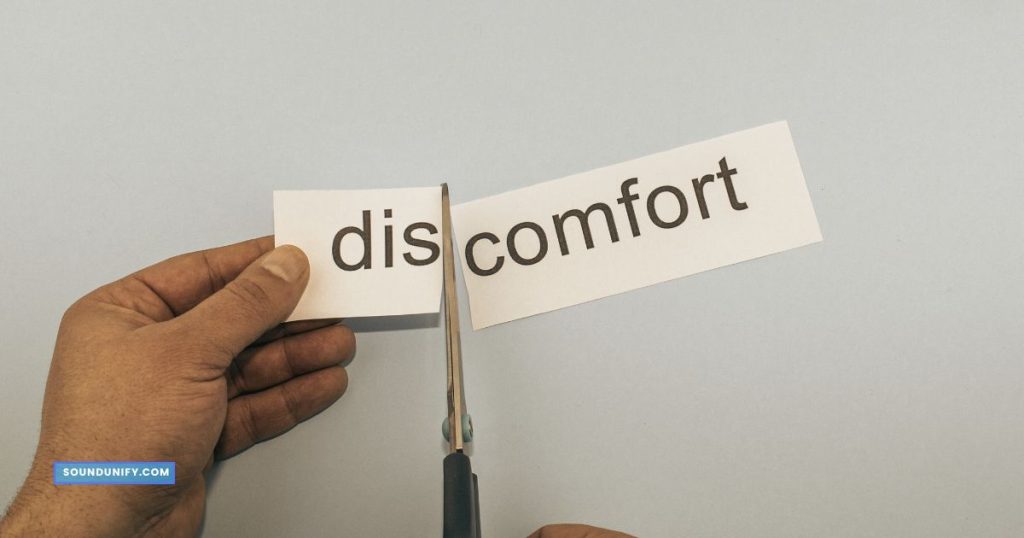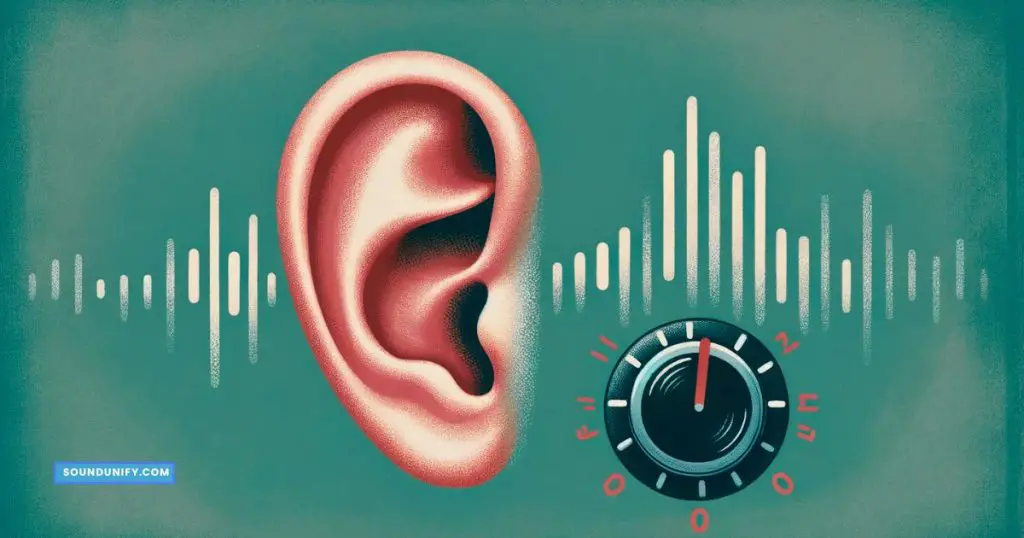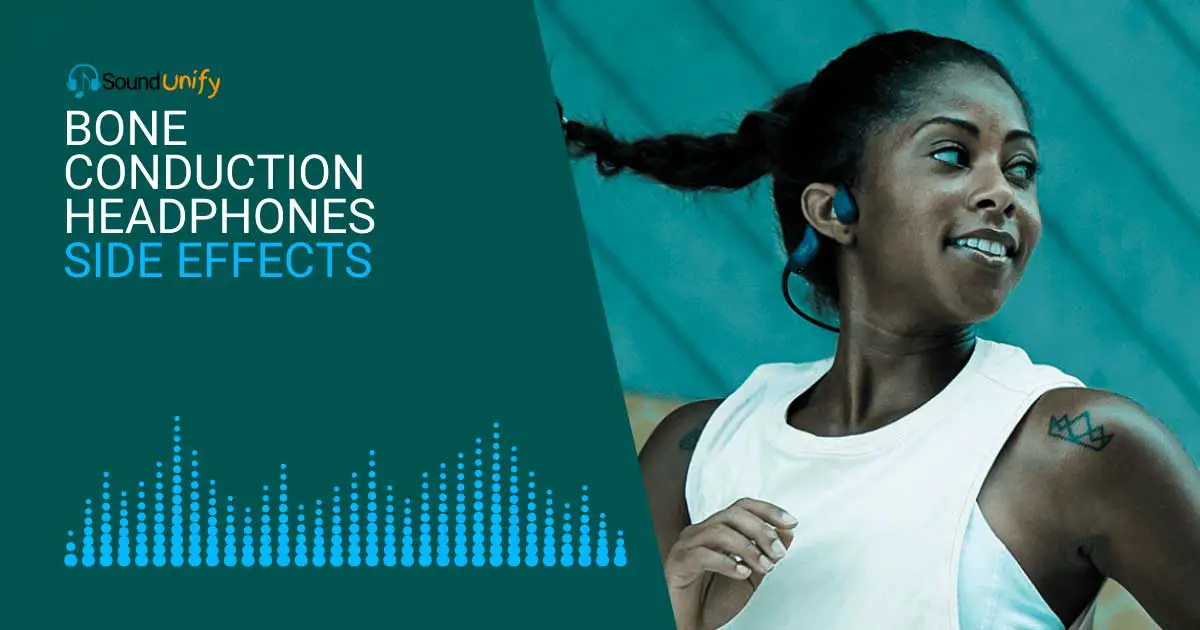Bone conduction headphones are an innovative technology that has captured the interest of many. It includes fitness enthusiasts and people with hearing impairments.
They transmit sound vibrations directly through your skull’s bones, bypassing the eardrum. The transducers in the headphones convert electrical signals into mechanical vibrations.
Which then travel through the bones to reach the inner ear. But, as with any new technology, there are potential side effects that users should be aware of.
In this article, I’ll discuss the possibility of bone conduction headphones side effects. Also, delve into the technical aspects, debunk some misconceptions, and offer solutions to help you make an informed decision.
Potential Side Effects of Bone Conduction Headphones
It’s essential to understand that side effects vary from person to person. What might bother one individual may not affect another.
With that in mind, let’s explore potential side effects and provide a deeper understanding of their technical aspects and possible treatments.
1. Discomfort or Pressure

Some users may feel discomfort or pressure on their cheekbones, temporal bones, or jaw when wearing bone conduction headphones. This sensation is due to the vibrations from the transducers.
The pressure exerted by the headphones’ headband. If you’re one of them, don’t worry!
You can try adjusting the fit or testing different models to find the most comfortable option. Look for models with adjustable headbands and cushioning to minimize pressure points.
Also, consider taking breaks during long listening sessions to give your facial bones and skin some rest.
2. Sound Leakage

Another issue that users may experience is sound leakage at high volumes. It cannot be very pleasant, especially in a quiet environment.
This problem occurs because the transducers generate vibrations that travel through the bones. And cause the surrounding air to vibrate, creating audible sound waves.
To avoid disturbing others, try maintaining a moderate volume level and opting for models designed to minimize sound leakage.
Some bone conduction headphones feature additional sound insulation or specialized transducers to reduce leakage.
3. Tinnitus Aggravation

Temporary worsening of tinnitus symptoms is a potential side effect for some users. The vibrations produced by bone conduction headphones can, in rare cases, aggravate existing tinnitus symptoms.
If you’re a tinnitus sufferer, closely monitor your symptoms using bone conduction headphones. If you notice any worsening, consult a healthcare professional or audiologist for personalized advice. They might recommend:
- Limiting the use of headphones.
- Adjusting the volume.
- Exploring alternative solutions.
4. Limited Audio Quality

Inferior audio quality compared to traditional headphones, particularly bass response, is a trade-off with bone conduction technology.
The transducers are less efficient at producing low-frequency vibrations than conventional headphones’ dynamic drivers.
At the same time, this might be an issue for audiophiles seeking high-fidelity audio experiences.
The unique benefits of bone conduction headphones, such as situational awareness and accessibility for those with hearing impairments, can outweigh this limitation.
If audio quality is a priority, research various models to find one that best balances audio performance and bone conduction technology’s benefits.
5. Headaches

Headaches are another possible side effect experienced by some users. The causes can range from pressure exerted by the headphones and vibration sensitivity to individual predispositions.
To minimize the risk of headaches:
- Try taking breaks during extended use.
- Adjusting the fit.
- Trying different models with better cushioning and ergonomics.
If headaches persist, consult a healthcare professional to rule out any underlying issues.
6. Vertigo or Dizziness

Rarely may some users experience vertigo or dizziness when using bone conduction headphones. These sensations might be due to the vibrations generated by the headphones or specific individual sensitivities.
If you experience vertigo or dizziness, discontinue use immediately and consult with a healthcare professional. They can help determine if the symptoms are related to the headphones or an underlying medical condition.
Sometimes, trying a different model or adjusting the volume might help alleviate these symptoms. However, it’s crucial to prioritize your well-being and seek professional guidance.
7. Skin Irritation

Skin irritation can occur at the contact points between the headphones and the skin. Particularly for users with sensitive skin or allergies to specific materials. To minimize the risk of skin irritation:
- Ensure that your bone conduction headphones fit properly.
- Don’t rub against your skin.
You can also try models with different materials, padding, or coatings that are hypoallergenic or designed for sensitive skin.
Regularly cleaning the headphones and taking breaks during long listening sessions can also help prevent irritation.
Addressing Misconceptions About Bone Conduction Headphones

There are several misconceptions surrounding bone conduction headphones, which can lead to confusion and unrealistic expectations.
To help you make more informed decisions, let’s address some common myths and misconceptions about this innovative technology.
1. They Are Completely Safe for Your Ears
Bone conduction headphones bypass the eardrum, reducing the risk of noise-induced hearing loss compared to traditional headphones. It’s important to remember that they’re not entirely risk-free.
Even with bone conduction technology, excessive loud volumes can still harm hearing. Therefore, practicing safe listening habits, such as maintaining a moderate volume and taking breaks during extended use, is crucial.
2. Cannot Cause Any Side Effects
As discussed earlier in this article, there are potential side effects associated with using bone conduction headphones. These may include discomfort, pressure, sound leakage, and headaches.
By acknowledging these potential side effects, users can take the necessary precautions and make more informed decisions about using bone conduction headphones.
3. They Are Only for People with Hearing Loss
Many people think bone conduction headphones can benefit individuals with conductive hearing loss. But they also offer unique advantages for people with normal hearing.
One key benefit is improved situational awareness, as bone conduction headphones open the ear canal. This allows users to hear ambient sounds and stay aware of their surroundings.
This makes them an excellent option for outdoor activities, such as running, cycling, or hiking.
4. Deliver the Same Audio Quality as Traditional Headphones
The sound quality is not as good as with regular headphones. Because bone conduction technology uses speakers that transmit sound through your bones.
It’s important to understand what you’re getting and know the limitations. Bone conduction headphones prioritize situational awareness and accessibility over high-fidelity audio experiences.
5. Can Cure Hearing Loss
Bone conduction headphones can improve audio experiences for individuals with certain types of hearing loss, such as conductive hearing loss.
They should not be considered a “cure” for hearing loss. Their effectiveness varies depending on the nature and severity of an individual’s hearing loss.
They may not be suitable for all types of hearing impairments. Consult an audiologist or healthcare professional for personalized advice on the best solution for your specific hearing needs.
Bone Conduction Headphones as a Cure for Hearing Loss

Bone conduction headphones have the potential to benefit individuals with certain types of hearing loss.
It’s essential to understand their limitations and effectiveness for different hearing loss types.
Let’s explore more points and details regarding bone conduction headphones and hearing loss.
Types of Hearing Loss
There are two primary types of hearing loss:
- Conductive Hearing Loss: This occurs when a problem with the outer or middle ear, such as a blockage or malformation. It prevents sound from reaching the inner ear.
- Sensorineural Hearing Loss: This type of hearing loss is due to damage to the inner ear, auditory nerve, or both, often caused by aging, noise exposure, or genetic factors.
Benefits of Conductive Hearing Loss
Bone conduction headphones can be particularly beneficial for individuals with conductive hearing loss.
They transmit sound vibrations directly to the inner ear, bypassing the outer and middle ears.
This direct transmission allows people with conductive hearing loss to experience better audio quality and communication.
Limitations for Sensorineural Hearing Loss
Bone conduction headphones might be less effective for people with sensorineural hearing loss. This type of hearing loss is related to damage in the inner ear or auditory nerve.
The headphones may not offer the same level of improvement as they do for conductive hearing loss.
However, some individuals with sensorineural hearing loss might still find bone conduction headphones helpful. It depends on the severity and nature of their hearing loss.
Not a Universal Solution
It’s crucial to understand that bone conduction headphones are not a one-size-fits-all solution for all types of hearing loss.
Their effectiveness varies depending on the individual’s specific hearing needs and the nature of their hearing loss.
Bone conduction headphones are not meant to fix hearing loss but can help some people hear better.
Consult an Audiologist or Healthcare Professional
If you have hearing loss and are considering using bone conduction headphones, it’s essential to consult with an audiologist or healthcare professional.
They can tell you if bone conduction headphones are right for you, explain what they can do, and their benefits and limitations. They can also help you find the best solution for your situation.
This personalized guidance ensures the most effective approach to addressing your hearing needs.
Safe Usage Guidelines for Bone Conduction Headphones
To maximize the benefits of bone conduction headphones while minimizing the risk of side effects, it’s crucial to follow safe usage guidelines.
Here are some tips to help you use bone conduction headphones responsibly and comfortably:
1. Maintain Moderate Volume Levels
Always keep the volume moderate to protect your hearing and minimize sound leakage. Excessively loud volumes can still cause hearing damage over time, even with bone conduction headphones. It’s essential to balance enjoying your audio and preserving your hearing health.
2. Take Breaks During Extended Use
Prolonged use of bone conduction headphones may cause discomfort, pressure, or even headaches for some users. Remember to take regular breaks during extended listening sessions to prevent these issues.
This will give your facial bones, skin, and inner ear some rest and help reduce the risk of adverse effects.
3. Choose the Right Fit and Model
Bone conduction headphones come in various designs, materials, and sizes. Choose a model that fits your head shape and size to ensure comfort and minimize potential side effects.
Look for adjustable headbands and cushioning to minimize pressure points. Trying out different models can help you find the most comfortable option.
4. Keep Your Headphones Clean
Maintaining the cleanliness of your bone conduction headphones can help prevent skin irritation and potential infections.
Regularly wipe down the contact points and headband with a gentle cleanser or disinfecting wipe to remove sweat, dirt, and bacteria.
This practice is especially important if you use your headphones during workouts or in humid environments.
5. Monitor Your Symptoms
If you experience discomfort, pain, or other side effects while using bone conduction headphones, stop using them and monitor your symptoms.
Consult a healthcare professional or audiologist if the symptoms persist or worsen. They can provide personalized advice and recommend alternative solutions if necessary.
6. Follow the Manufacturer’s Guidelines
Always read and follow the manufacturer’s guidelines and recommendations for your specific bone conduction headphones model.
These guidelines can help you use, care for, and fix your headphones to get the most out of them without hurting yourself.
Proper Care and Maintenance
Taking care of your bone conduction headphones ensures their longevity and optimal performance. Here are some tips on proper care and maintenance:
- Clean your headphones regularly: Wipe down the contact points and headband with a gentle cleanser or disinfecting wipe to remove sweat, dirt, and bacteria. This practice is especially important if you use your headphones during workouts or in humid environments.
- Store your headphones in a protective case: When not in use, store your bone conduction headphones in a protective case to prevent damage from dust, moisture, and impact. This helps keep them in good condition and extends their lifespan.
- Avoid exposing your headphones to extreme temperatures: Extreme heat or cold can damage the internal components of your headphones. Store and use your bone conduction headphones within the recommended temperature range specified by the manufacturer.
- Handle with care: Be gentle when putting on and removing your headphones, and avoid pulling on the cables or headband with excessive force. This can prevent damage to the internal components and prolong their lifespan.
- Monitor for signs of wear or damage: Regularly inspect your headphones for any visible wear or damage, such as frayed cables, loose connections, or cracked components. If you notice any issues, consult the manufacturer or a qualified technician for repair or replacement.
How to Choose the Right Bone Conduction Headphones?
When selecting bone conduction headphones, consider the following factors to find the best option for your needs:
- Comfort: Look for adjustable headbands and cushioning to minimize pressure points and ensure a comfortable fit, especially during extended use.
- Audio quality: While bone conduction headphones prioritize situational awareness over high-fidelity audio, it’s still essential to consider the overall sound quality. Test different models to find one that meets your audio clarity and bass response preferences.
- Battery life: Choose a model with a battery life that suits your usage habits, whether you need them for short workouts or extended listening sessions.
- Water and sweat resistance: If you plan to use your headphones during workouts or outdoor activities, opt for a water and sweat resistance model to protect against moisture damage.
- Compatibility: Ensure your headphones are compatible with your preferred devices, such as smartphones, tablets, or MP3 players.
- Price: Consider your budget when selecting bone conduction headphones, and remember that investing in a quality model can provide better comfort, durability, and performance.
Popular Bone Conduction Headphone Brands and Models
Some popular bone conduction headphone brands and models include:
- Shokz: SHOKZ OpenRun is their best-selling model. Shokz is a leading brand in the bone conduction headphones market. Their headphones are lightweight, comfortable, and offer good sound quality and battery life.
- Vidonn: The Vidonn F1 is a popular budget-friendly option that provides decent sound quality, comfort, and battery life, making it an attractive choice for those new to bone conduction headphones.
- Tayogo: The Tayogo S2 is a waterproof model suitable for swimming and water sports enthusiasts. It offers good sound quality, comfort, and battery life.
- Bose: While not primarily focused on bone conduction headphones, Bose has the SoundWear Companion Speaker, which utilizes a unique hybrid design that combines bone conduction and traditional speaker technology for a unique listening experience.
Real-Life Experiences and Testimonials
- Outdoor enthusiasts: Many users appreciate the improved situational awareness provided by bone conduction headphones, allowing them to hear their surroundings while enjoying music during activities such as running, cycling, or hiking. Users often report feeling safer and more connected to their environment, making their outdoor experiences more enjoyable.
- Individuals with hearing loss: Some users with conductive hearing loss have found bone conduction headphones to be a game-changer, enabling them to enjoy music, podcasts, and phone calls with significantly improved audio quality. While not a solution for all types of hearing loss, many have experienced a positive impact on their daily lives.
- Office workers: People in open office environments have reported using bone conduction headphones to listen to music or take calls without disturbing their coworkers. The open-ear design allows them to maintain awareness of their surroundings and engage in conversations without removing their headphones.
FAQ
Can I use bone conduction headphones while swimming?
Not all bone conduction headphones are suitable for swimming. Only waterproof models, such as the Tayogo S2, are designed for use in water. Check the manufacturer’s guidelines and specifications to confirm whether your headphones suit swimming.
Can bone conduction headphones cause headaches?
Some users may experience discomfort or headaches during extended use due to the pressure exerted on the facial bones. Taking regular breaks and ensuring a comfortable fit can help mitigate this issue.
Are bone conduction headphones suitable for children?
Bone conduction headphones are generally safe for children, as they do not block the ear canal and allow for ambient sound awareness. However, it’s essential to maintain moderate volume levels and supervise usage to prevent any potential risks to their hearing.
Can I use bone conduction headphones with glasses or hearing aids?
Yes, most bone conduction headphones can be used comfortably with glasses or hearing aids. Look for models with slim or flexible headbands that can accommodate both without causing discomfort.
How long does the battery last on bone conduction headphones?
Battery life varies depending on the specific model and usage habits. Most bone-conduction headphones offer 6 to 8 hours of continuous playback, but some models can last up to 12 hours. Always check the manufacturer’s specifications for accurate battery life estimates.
Before You Go…
Now you know the side effects of bone conduction headphones. But If you want to get more knowledge, then read related articles. You can comment below if you have anything in your mind.
James Dimento is a Chief-in-Editor of SoundUnify. He is a headphone enthusiast and creative writer passionate about audio technology. He has three years of experience writing about headphones and sound quality and is responsible for creating reviews and taking care of all administration.
